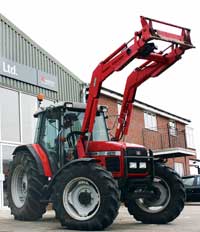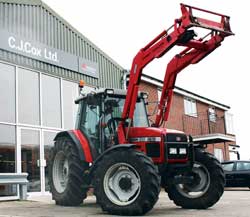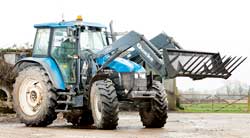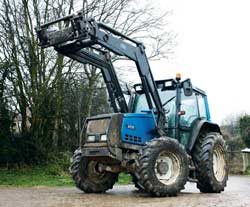Buying a second-hand 110hp loader tractor – MF, New Holland or Valtra

The tractor-plus-front-loader is the pack-pony of British agriculture. Expected to start and run flawlessly every day, these stalwarts rarely get the attention they deserve.
So when you’re thinking about buying a second-hand machine, it’s important to give it a thorough once-over to check it hasn’t suffered too much abuse or neglect.
We tracked down three examples with price tags ranging between £15,000 and £20,000 and all hovering around the 110hp mark. All have clutchless powershuttles but vary in their mechanical, hydraulic and electronic complexity.
Although all our contenders differ in a number of ways, there is still a range of common danger areas to look for on any tractor that has spent a lot of time with a loader on its nose.
Front end
First to the front axle. A loader puts extra strain through the front end and it’s the weight-bearing components of the axle that bear the brunt.
For starters, look for signs of grease around the main pivot points and bearings. If they’re dry, and clearly have been for some time, it’s a good indicator that maintenance wasn’t high on the priority list of the previous owner.
Jack the front wheels up and give them a good yank, checking for play in the bearings above and below the hub-carrier yoke.
Next get in the cab and, with the engine running, swing the steering wheel from side to side, checking for slack in the track-rod ends. Some play is acceptable but serious slop will mean replacement is needed. It’s not a big job but factor in anything between £40 and £100 to cover parts.
Then, as part of your road test, accelerate to top speed, listening for any front-end clonks between gear changes and over bumps that could indicate worn main axle pivot bushes.
Sticking to the front end, it’s common to find damage to loader tractors’ nose cones and grilles. While this might seem cosmetic, damaged bonnets often mean smashed or defunct headlights, making the tractor unroadworthy.
In addition, the grille performs an essential role in keeping the radiators clean, so any damage will mean more muck and debris is drawn in by the fan, potentially leading to over-heating.
Lift the hood and check the condition of the rads. If uncleaned for a some time, the fins will clog and the combination of chopped straw, dust and milled corn can often set like concrete – almost impossible to remove without damage.
If an engine has been cooked or regularly over-heated, it will usually show up with a leaky water-pump and paint peeling off the block because of heat-stress.
Wheels and tyres
Because of the extra stress exerted by a loader and the type of environment they are expected to work in, wheel rims often take a hammering.
Muck, slurry and gateposts all cause corrosion, buckling and rotting of rims, while the shock-loadings take their toll on lugs and centre dishes over time. Look out for cracks and welding and factor in at least £200 per rim for replacements on the front end.
Check the tyres, too – scrubbed sidewalls are a common battle scar and wear is often accelerated by the high proportion of time these machines spend shuttling backwards and forwards on concrete.
Loader tractors that have been run without back-end ballast can suffer from excessive rear-end rubber wear. Expect to shell out more than £2300 to re-shoe all four corners.
Back end
It’s standard stuff around the rear of all these tractors. Look out for worn trailer hitches and bent or broken linkage parts. Drop-rod adjusters and stabilisers should all swivel and slide freely.
General condition
Finally, assess the tractor on its overall condition. First impressions are often the right ones – if it looks like it’s done six months in Helmand Province steer clear.
Loader checklist
• All our contenders are fitted with Alo Quicke-derived loaders, the MF 4270 and Valtra 6550 bearing re-badged versions of the Scandinavian market leader’s popular models.
• The New Holland TS115 has a big advantage – it was kitted out with a loader just over a year ago so it will have suffered less wear and tear than its counterparts.
• Be prepared to pay at least £200 more for a loader fitted with suspension.[Bold] This extra pays dividends in the long run, not only making a smoother ride, but taking the stress and strain out of everyday work for the tractor.
• Two gas accumulators are plumbed into the main lift/lower circuit, providing cushioning for both up and down jolts. Later versions have resistance adjustment to allow the operator to tweak things according to the load being carried.
• To check everything is working as it should, lift the loader a foot or so off the ground and bounce up and down on the carriage. The damping effect should be obvious, but if it is absent, it is rarely a major drama – the accumulator spheres may just need a re-charge.
• To check for general wear and tear, park the tractor on level ground, slowly drop the jib on to the deck and check to see the carriage lands squarely on the ground. At the same time, look out for slop in the pins at the base of the main lift rams – these tend to suffer most abuse.
• Similarly, rock the attachment carriage back and forwards – any slack will be easy to spot. • Examine the cast yokes that connect the carriage to the crowd rams – these can crack. Finally, check that the locking pins (and their carrier rams) run smoothly to and fro.
• Mechanical self-levelling is a common feature and one that makes life a bit easier around the yard. Be prepared to pay another £200-£300 for a machine equipped with this.
• Cable controls are still standard fare, but be aware that electric controls will add a £400-£500 premium.
Massey Ferguson 4270
The largest two models in MF’s 4200 series, the 4260 and 4270, differed from their siblings as they have an unblown six-cylinder engine rather than the smaller three- and four-pot powerplants used lower down the range.
For some, the extra stability of the longer wheelbase proves a bonus; for others the more limited manoeuvrability is an issue. Either way, these are considered straightforward, reliable plodders.
On the engine front, the Perkins six-pot is a well-known entity, offering good lugging characteristics, a thirst for oil and that familiar plume of black smoke at full chat. It’s not known for major mechanical headaches.
This example is kitted out with the top-spec 24F x 24R powerShuttle transmission – a straightforward three-range, four-speed box with splitter.
Range selection is novel – to avoid having a separate stick, MF came up with an ingenious ratchet mechanism that means knocking the lever across to the right and shimmying up and down through high, medium and low ratios.
Useful as this seems, it adds an extra level of complication and, as always seems to be the way with clever mechanisms, can be the source of trouble. Simple 50p-sized springs in the ratchet mechanism can break off inside the transmission, leaving the tractor stuck in one range. While the replacement parts cost pennies, the repair requires the tractor to be split – a good one and a half day’s labour.
On the plus-side, MF’s power-shuttle is excellent and has the added benefit of a simple dial to control the aggressiveness of direction changes. Expect to pay £1500-£2000 more for a powershuttle-equipped tractor.
Around to the back end, things are fairly lightweight. The 4200s share much in common with the original MF165s and 185s. On the plus side, this means that the majority of functions are mechanically controlled – arm-draulic levers are the order of the day (and even external controls are included).
On the downside, this limits the 4270 somewhat. With its Ferguson-system top-link draft-sensing, it isn’t a heavy ploughing tractor. The brakes are also fairly weedy so don’t expect this to be a heavy haulage machine. It is, however, capable of most dairy farm duties.
| |
Year | 2000 |
Hours | 5774 |
Condition | Good |
Power | 110hp @ 2200rpm (114hp max) |
Engine | 6-litre naturally asthmatic Perkins 6-cyl |
Transmission | 24F x 24R – three-range, four-speed manual with clutch-less splitter and power-shuttle |
Linkage lift | 5000kg |
Hydraulic output | 66-litres/min |
Weight | 4.1t |
New Holland TS115
TS tractors were some of the first Ford-derived products to receive any real Fiatagri influence. Despite some preconceptions, this had a positive impact on build quality.
The time-proven and robust Fiat front axle was adopted rather than the Carraro unit used previously – this had particularly positive connotations for loader-tractor buyers.
By the time the TS115 came on the market, Ford’s issues with porous blocks were a thing of the past. Basildon-built Powerstar engines had proved themselves to be bullet-proof in the company’s 40-series tractors and the six-pot powerplant employed in the largest TS became a real selling point.
These engines rarely give any trouble when looked after. Overly ticky tappets are a good indicator that a tractor hasn’t been regularly serviced – aim to dig out some sort of maintenance record.
A straight-six engine may be better for pottering around the yard as it doesn’t have the extra complications of a turbocharger, which requires a good, clean supply of oil. That said, many TS115s received the after-market turbo treatment that often took them up beyond 125hp.
On the gearbox front there is rarely anything to fault the 24F x 24R Dual-Power mechanical transmission on. If anything does go wrong, it’s likely to be the splitter unit, which can become cooked. Select first gear in high range and gently ease the mechanical shuttle in. If there is any fighting, seek specialist advice.
The more sophisticated electro-command four-step powershift box can have issues with its shuttle synchronisers. While holding the tractor on the brakes, switch between forwards and reverse, listening for any graunching that could indicate an issue with the synchros.
Sorting the issue involves splitting the tractor (a day and a half’s labour) and £800 of parts. Clutch damper plates can also wear. Run the tractor and then shut it off, listening for ting-tings from the transfer casing, which could indicate loose springs. Oil dripping from the bell-housing could mean a spring has worked loose and damaged the main shaft seals.
TS115 brakes are an area of strength. Three or four-plate multidisc units provide excellent stopping power and rarely break up to contaminate back-end oil. Changing them is a straightforward, trumpets-off job.
New Holland’s swing-back pick-up hitches are a great concept but tend to suffer wear. Once truly sloppy and out of adjustment, replacement is often the only answer. An original unit comes in at more than £2000, where as a Dromone substitute costs about £800.
| |
Year | 1999 |
Hours | 4574 |
Condition | Mint |
Power | 115hp @ 2200rpm (115hp max) |
Engine | 7.5-litre naturally-aspirated NH Powerstar 6-cyl |
Transmission | 16F x 16R – two range, two-speed manual with four-speed power shift and clutchless shuttle |
Linkage lift | 6900kg |
Hydraulic output | 79litres/min |
Weight | 4.7t |
Valtra 6550
Known for their Scandinavian solidity, Valtras regularly feature as many livestock farms’ prime loader tractor. The only four-cylinder tractor of our trio, the 6550 is also the lightest. The four-pot Sisu engine is renowned for longevity. As one dealer puts it: “The electrics and hydraulics might fail once you get to 10,000 hours, but the Sisu motor just runs and runs.”
So, no real trouble there – just be aware that, like with other loader tractors, the 6550’s rads are prone to blockage and over-heating.
One particularly useful feature is an auto-shutdown facility. Designed to work when the tractor is left working unattended (stirring slurry, for example), ControlStop monitors engine oil pressure and temperature plus back-end temperature and oil pressure and, should these rise above certain levels, kills the engine to protect it from damage.
Great as this is, be aware that with the ControlStop switch flicked, the tractor won’t start – a common reason for calls to Valtra service engineers.
The Finnish firm’s 36-speed gearbox offers the greatest range of working speeds of all three tractors and rarely gives trouble. Issues are usually easy to sort and often involve failed switchgear for the three-stage gear splitter.
A simple test for transmission wear is to start the engine and gently lean on the main gear lever without the assistance of the clutch. The tractor should try to roll forward, but if there is any grinding it could indicate that the synchros are beginning to wear.
Although most 6550s will be kitted out with a powershuttle, a lower-spec version is available with mechanical shuttle and mechanical (rather than electric) linkage controls. These tend to be £2000-£3000 cheaper on the second-hand circuit.
Round to the back, look out for common wear and tear, paying attention to pin-and-slot link-arm stabilisers and the cast drop-rod yokes that can wear and crack.
Another big Valtra bonus is externally-adjustable brakes. As stopping power diminishes over time, it’s a case of grabbing a spanner and tweaking up a simple screw adjuster.
One weak point on these tractors can be the tin-work. The multi-piece bonnet’s fiddly-to-latch side panels can drop off if they are not attached properly and can end up either bent or missing. Similarly be aware that the grill that retains the cab air filter can work loose and drop off – a minor but annoying issue.
Other things to look out for in the cab area are bent or broken steps, cracked or welded seat mountings and worn-off switchgear decals.
In the main though, these are solid little loader tractors, which is reflected in their second-hand value.
| |
Year | 2002 |
Hours | 7462 |
Condition | Average |
Power | 105hp @ 2200rpm (105hp max) |
Engine | 4.4-litre Sisu 4-cyl turbo |
Transmission | 36F x 36R – three-range, four-speed manual with three-speed clutchless splitter and power-shuttle |
Linkage lift | 5600kg |
Hydraulic output | 73-litres/min |
Weight | 4.66t (with full fuel tank) |
Thanks to
Chris Cox at Dorset Valtra dealer CJ Cox; Sam Read and Brian Yeates at Somerset Valtra dealer Read Agri; Andrew Collier and Paul Churches at Wiltshire New Holland dealer TH White; and tractor owners Rob Cary, James and Mark de Pais.

 Massey Ferguson 4270
Massey Ferguson 4270  New Holland TS115
New Holland TS115  Valtra 6550
Valtra 6550